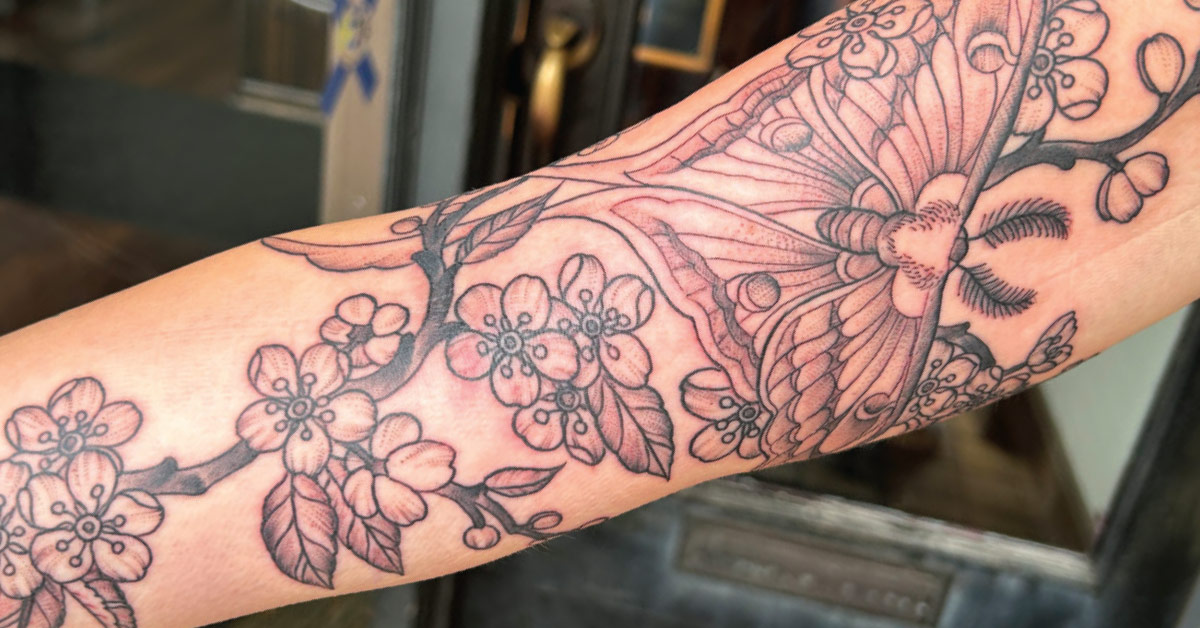You want to commemorate something. That band, maybe—the one whose music you’d listen to late at night, when the world was crumbling around you.
Or the symbol carved into the wall your mother was leaning on in your favorite photograph of her, taken years before she got the bad diagnosis. Or maybe you’ve just always wanted a tattoo.
In his nearly quarter century in the field, Gareth Hawkins of Sovereign Arms Tattoo Co. has seen it all: everything from people who know exactly what they want, to those who just know they want something.
In the latter cases, he helps them talk it out. “Through a lot of talk, we start to nail it down,” he said. “The idea, the style, the contents of the image. It’s not quite like mind-reading, but it’s a little like that. Eventually we get there.”
Of course, to get there, you have to be there: There with Hawkins, or with a tattoo artist and facility you can trust, anyway. That requires making a decision—according to the Michigan Department of Health and Human Services, Kent County alone has 104 licensed facilities. Add in the rest of West Michigan, and you have a village.
To Hawkins, it’s less about finding a facility than finding an artist. Industry-wide, artists tend to change shops with some frequency. While shops might specialize in certain styles, ultimately it’s the tattoo artist who’ll be wielding the needle.
“Look online. You always want to look at their artwork, including recent tattoos they’ve done, healed tattoos. That’s the best thing to look for.” He suggests asking around, too. Word of mouth still beats social media.
Once you’re ready, you may need to book that initial consultation in advance; your preferred artist might be booked months ahead. Regardless, you’ll talk to him or her about what you want. Sometimes, the artist might need to redirect you. “This is permanent art,” Hawkins said. “I’ve done this long enough to see that some things don’t hold up. Something’s too small, or it’s on a certain part of the body that doesn’t hold ink very well. Tattoos are supposed to last a lifetime, but certain styles just aren’t good for longevity.”
And when the day of your appointment (or the first of multiple appointments) comes, go in sober. It’s illegal in Michigan to give tattoos to drunk people. If you aren’t sober, your artist is probably going to kick you out. And if that doesn’t happen, it’s probably not an artist you’d want to work with anyway.
There’ll be paperwork. You’ll sit or lie down in a chair. And there’ll be a discussion about pain. “I always tell people it’s going to hurt,” Hawkins said. “Regardless of what you think, it’ll hurt. I want people to expect the worst, just in case. Then, if it’s not so bad, people will say, ‘Huh, it’s not as bad as I thought it would be.’”
For some, the sensation of tiny drops of ink being injected into the top layer of skin feels like cat scratches. Some cats are bigger than others, of course. But you’ll manage the pain.
Afterward, you’ll be given instructions about how to care for the tattoo. You’ll want to avoid direct sunlight for a while. Also something you should avoid: submerging the tattooed area. Tight clothes, too. You might notice that your skin’s red, itchy, or sore. You might see ink coming out, or blood, or fluid. That’s normal. You’re healing.
Sometimes, it’ll hit you: Hey. I’ve got a tattoo.
By having one, you’ve joined a community of people wearing Hawkins’ art. That’s assuming you went with him, of course. And that he went with you. Mostly, he will. Sometimes, though, he’ll turn you away.
That might be because you want a tattoo in a style he doesn’t specialize in, and he wants to make sure you get the best possible work done. Or maybe you’re a minor; if you’re sixteen or seventeen, Michigan allows you to get a tattoo as long as you have parental permission. “That’s way, way young,” he said. “At that point, they’re compromising with their parents. I’ve done too many cover-ups for people who get a tattoo young and later regretted it.”
He won’t tattoo certain things either. If you want a gang symbol, or a hate symbol, well, there are tattoo artists who’ll do it. But you won’t be getting it done at Sovereign Arms. Barring that, he’s open.
Lately, he’s found himself tattooing the kids of people he tattooed in the past. “It’s happening quite a bit,” he said. “It feels really good.” He sees it in part as a transformation in the culture: when he was young, tattoos were often perceived negatively. “You had to hide it from your parents. Now, parents have them. It’s more accepted.”
What does he want his clients to walk away with? A good experience and a great tattoo. “You shouldn’t walk into a place and feel like the staff is looking down on you. If you do, walk out. If you get a good tattoo but hated the experience, hey. But if you enjoyed the experience, you’ll cherish the tattoo that much more.”
That’s what a tattoo should be: something to cherish.





